Organizational Behavior Report: Theories, Skills, and Practices
VerifiedAdded on 2022/12/14
|11
|911
|278
Report
AI Summary
This report provides an overview of organizational behavior, exploring the behavior of employees and groups within corporate settings. It examines emerging trends such as open systems and self-discipline, major theories related to individual and group development, including scientific management theory, and the importance of teamwork skills. The report also delves into organizational structure, highlighting hierarchy structures and techniques for effective management. Furthermore, it discusses the qualities of effective leadership and their impact on organizational success, emphasizing communication as a key attribute. The conclusion emphasizes the significance of setting clear goals, rules, and regulations to foster responsible behavior and achieve success in a diverse market environment. The report references scholarly articles on related topics.
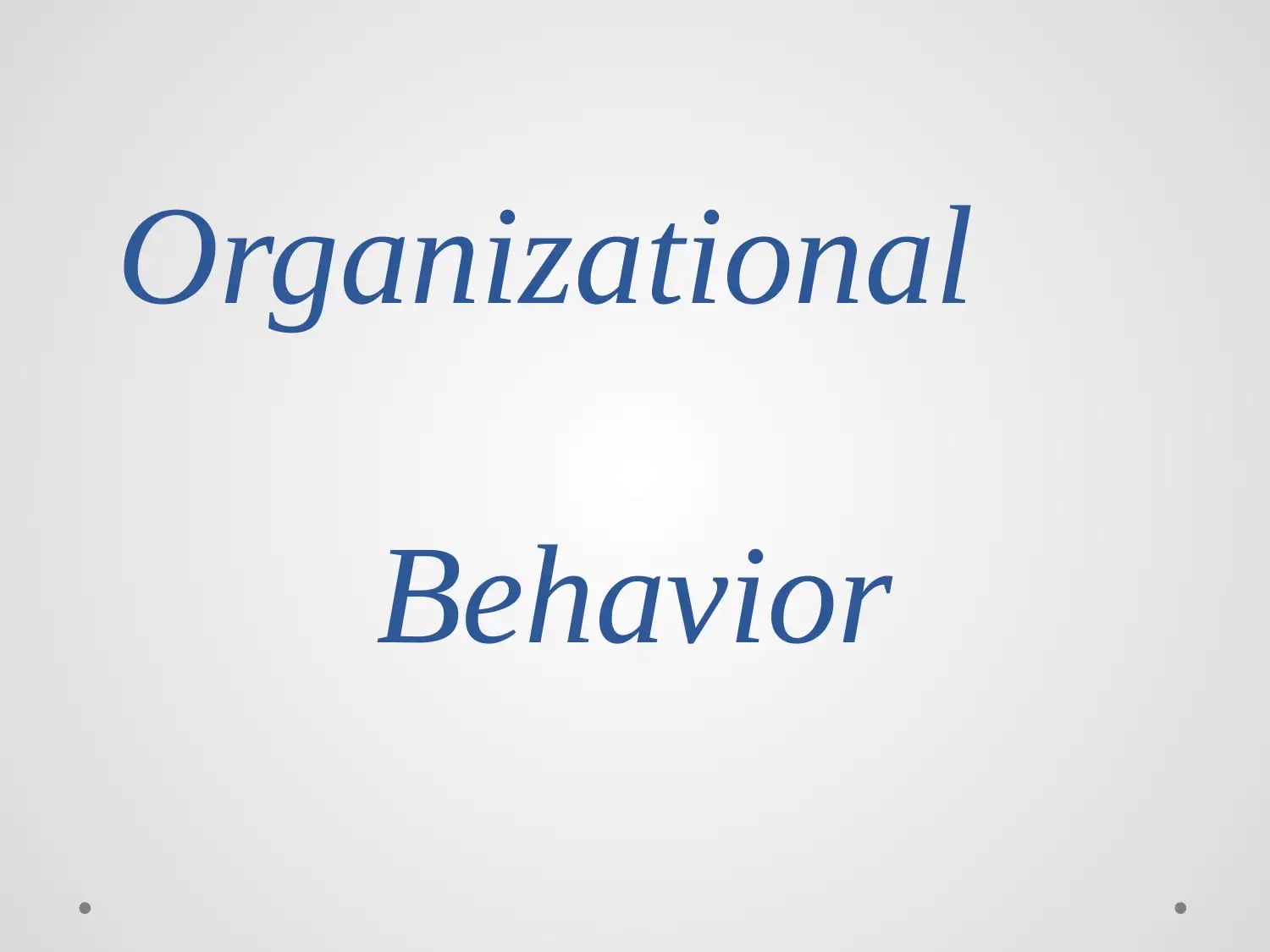
Organizational
Behavior
Behavior
Paraphrase This Document
Need a fresh take? Get an instant paraphrase of this document with our AI Paraphraser
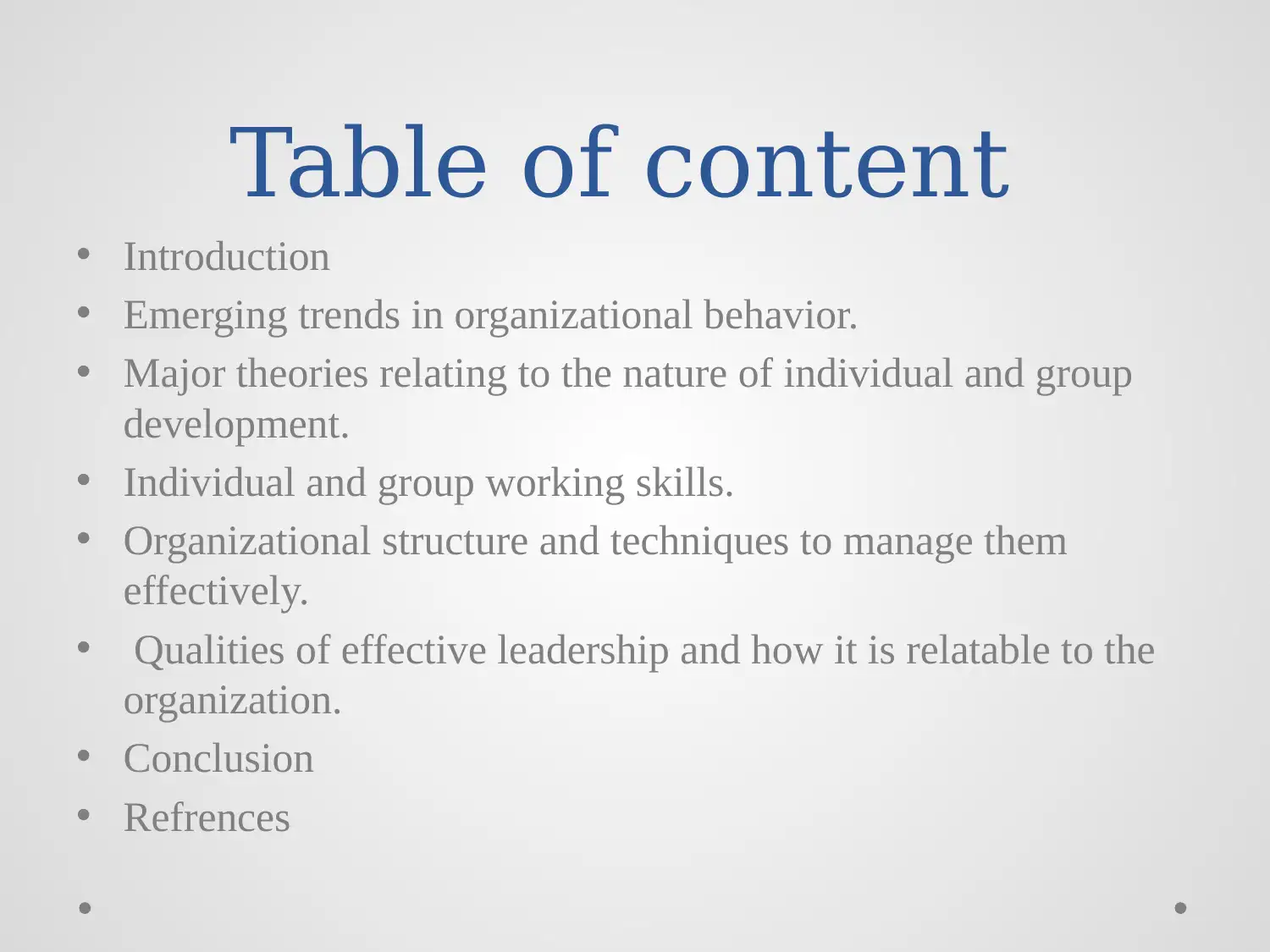
Table of content
• Introduction
• Emerging trends in organizational behavior.
• Major theories relating to the nature of individual and group
development.
• Individual and group working skills.
• Organizational structure and techniques to manage them
effectively.
• Qualities of effective leadership and how it is relatable to the
organization.
• Conclusion
• Refrences
• Introduction
• Emerging trends in organizational behavior.
• Major theories relating to the nature of individual and group
development.
• Individual and group working skills.
• Organizational structure and techniques to manage them
effectively.
• Qualities of effective leadership and how it is relatable to the
organization.
• Conclusion
• Refrences

INTRODUCTION
• Organizational Behavior can be explain as
a study of behavior of employees and
groups in the corporate offices. To gain
short and long term goals, the business
leader requires to understand what
motivate staff people and how they are
interacting with each other in the
organization.
• These areas may include employee’s
training and development, collaboration
and innovation (Jehanzeb, K., 2021).
• Organizational Behavior can be explain as
a study of behavior of employees and
groups in the corporate offices. To gain
short and long term goals, the business
leader requires to understand what
motivate staff people and how they are
interacting with each other in the
organization.
• These areas may include employee’s
training and development, collaboration
and innovation (Jehanzeb, K., 2021).
⊘ This is a preview!⊘
Do you want full access?
Subscribe today to unlock all pages.

Trusted by 1+ million students worldwide

Emerging trends in
organizational behavior
During a passage of time over the years, a
HR manager have adopted different
practices to manage the behavior of
employees in the organization. It all start
from autocratic model to collegial model
ultimately. Different scholars of
organizational behavior shows different
emerging trends in the OB.
Open system: There are two systems in the
organization one is open and another is close
system. The trend is towards the open
system in the organization.
organizational behavior
During a passage of time over the years, a
HR manager have adopted different
practices to manage the behavior of
employees in the organization. It all start
from autocratic model to collegial model
ultimately. Different scholars of
organizational behavior shows different
emerging trends in the OB.
Open system: There are two systems in the
organization one is open and another is close
system. The trend is towards the open
system in the organization.
Paraphrase This Document
Need a fresh take? Get an instant paraphrase of this document with our AI Paraphraser
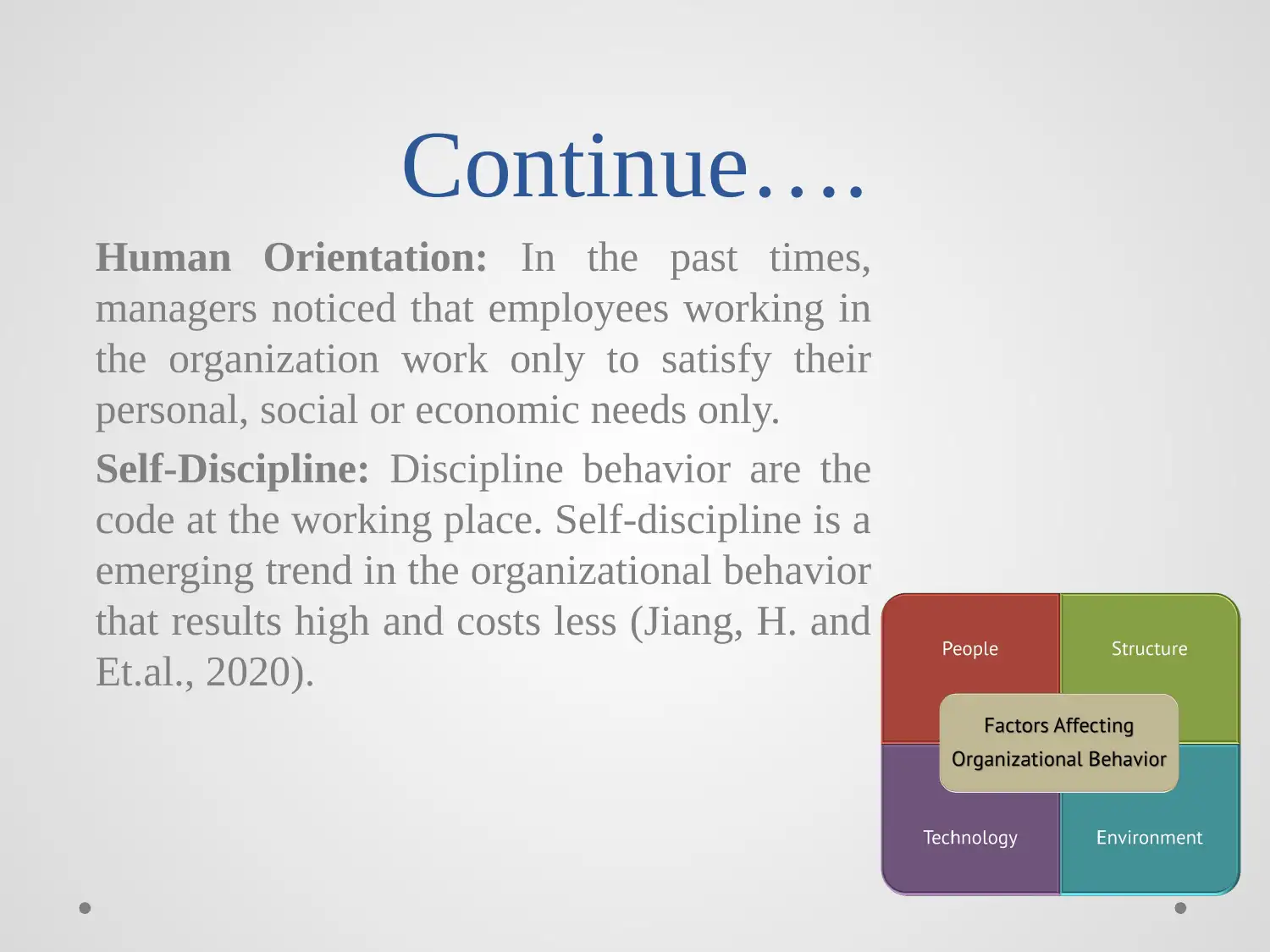
Continue….
Human Orientation: In the past times,
managers noticed that employees working in
the organization work only to satisfy their
personal, social or economic needs only.
Self-Discipline: Discipline behavior are the
code at the working place. Self-discipline is a
emerging trend in the organizational behavior
that results high and costs less (Jiang, H. and
Et.al., 2020).
Human Orientation: In the past times,
managers noticed that employees working in
the organization work only to satisfy their
personal, social or economic needs only.
Self-Discipline: Discipline behavior are the
code at the working place. Self-discipline is a
emerging trend in the organizational behavior
that results high and costs less (Jiang, H. and
Et.al., 2020).
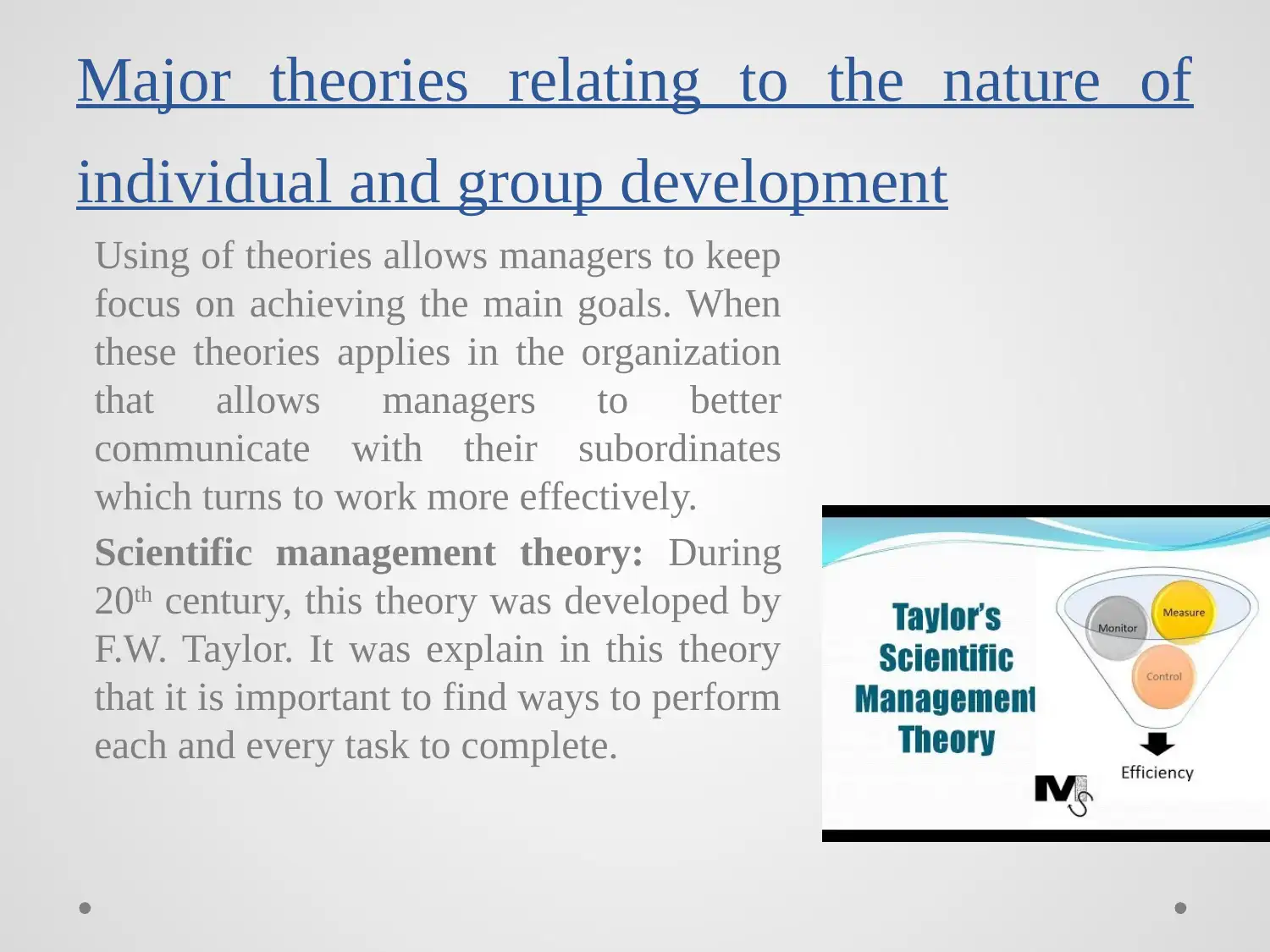
Major theories relating to the nature of
individual and group development
Using of theories allows managers to keep
focus on achieving the main goals. When
these theories applies in the organization
that allows managers to better
communicate with their subordinates
which turns to work more effectively.
Scientific management theory: During
20th century, this theory was developed by
F.W. Taylor. It was explain in this theory
that it is important to find ways to perform
each and every task to complete.
individual and group development
Using of theories allows managers to keep
focus on achieving the main goals. When
these theories applies in the organization
that allows managers to better
communicate with their subordinates
which turns to work more effectively.
Scientific management theory: During
20th century, this theory was developed by
F.W. Taylor. It was explain in this theory
that it is important to find ways to perform
each and every task to complete.
⊘ This is a preview!⊘
Do you want full access?
Subscribe today to unlock all pages.

Trusted by 1+ million students worldwide
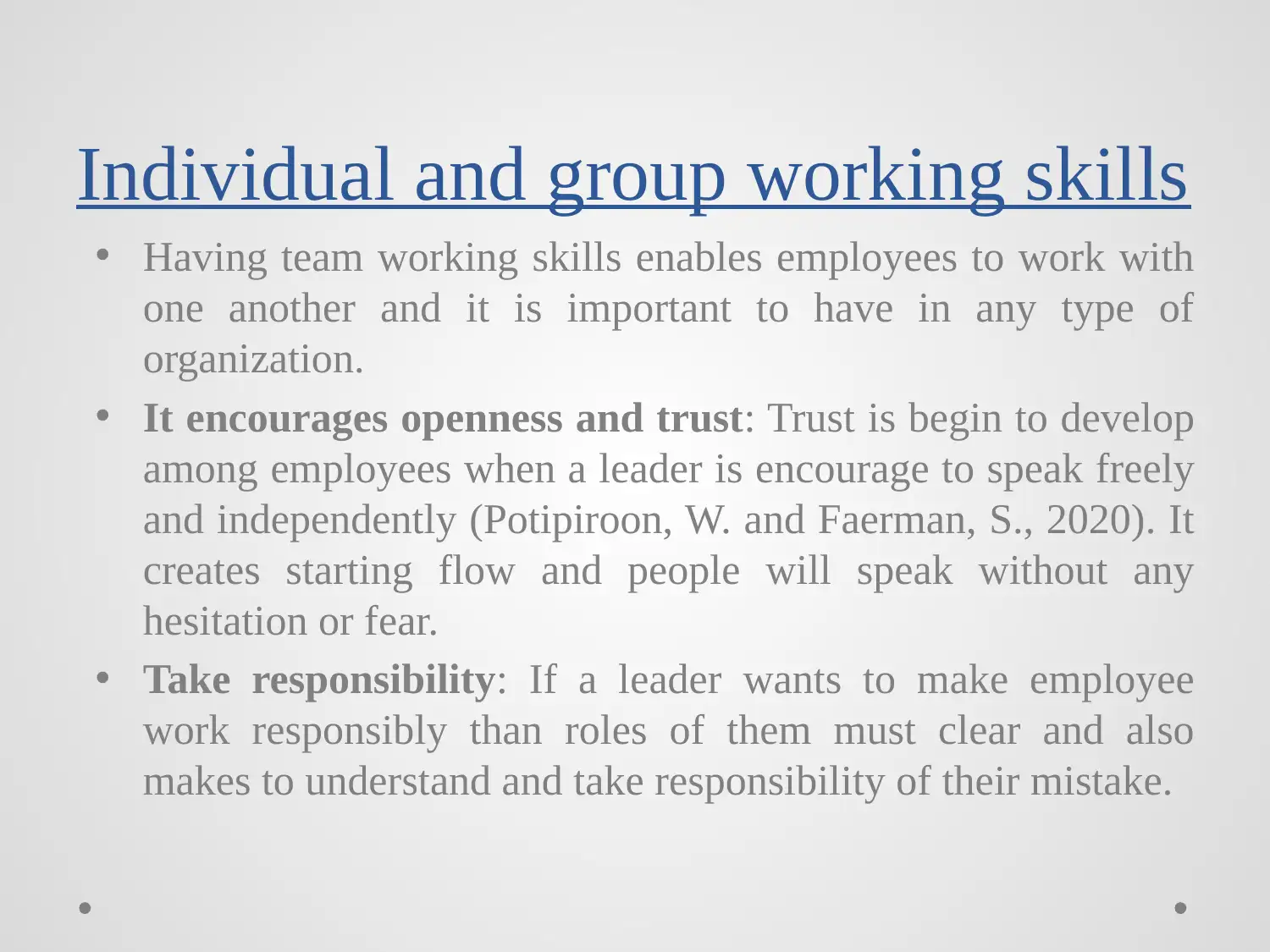
Individual and group working skills
• Having team working skills enables employees to work with
one another and it is important to have in any type of
organization.
• It encourages openness and trust: Trust is begin to develop
among employees when a leader is encourage to speak freely
and independently (Potipiroon, W. and Faerman, S., 2020). It
creates starting flow and people will speak without any
hesitation or fear.
• Take responsibility: If a leader wants to make employee
work responsibly than roles of them must clear and also
makes to understand and take responsibility of their mistake.
• Having team working skills enables employees to work with
one another and it is important to have in any type of
organization.
• It encourages openness and trust: Trust is begin to develop
among employees when a leader is encourage to speak freely
and independently (Potipiroon, W. and Faerman, S., 2020). It
creates starting flow and people will speak without any
hesitation or fear.
• Take responsibility: If a leader wants to make employee
work responsibly than roles of them must clear and also
makes to understand and take responsibility of their mistake.
Paraphrase This Document
Need a fresh take? Get an instant paraphrase of this document with our AI Paraphraser
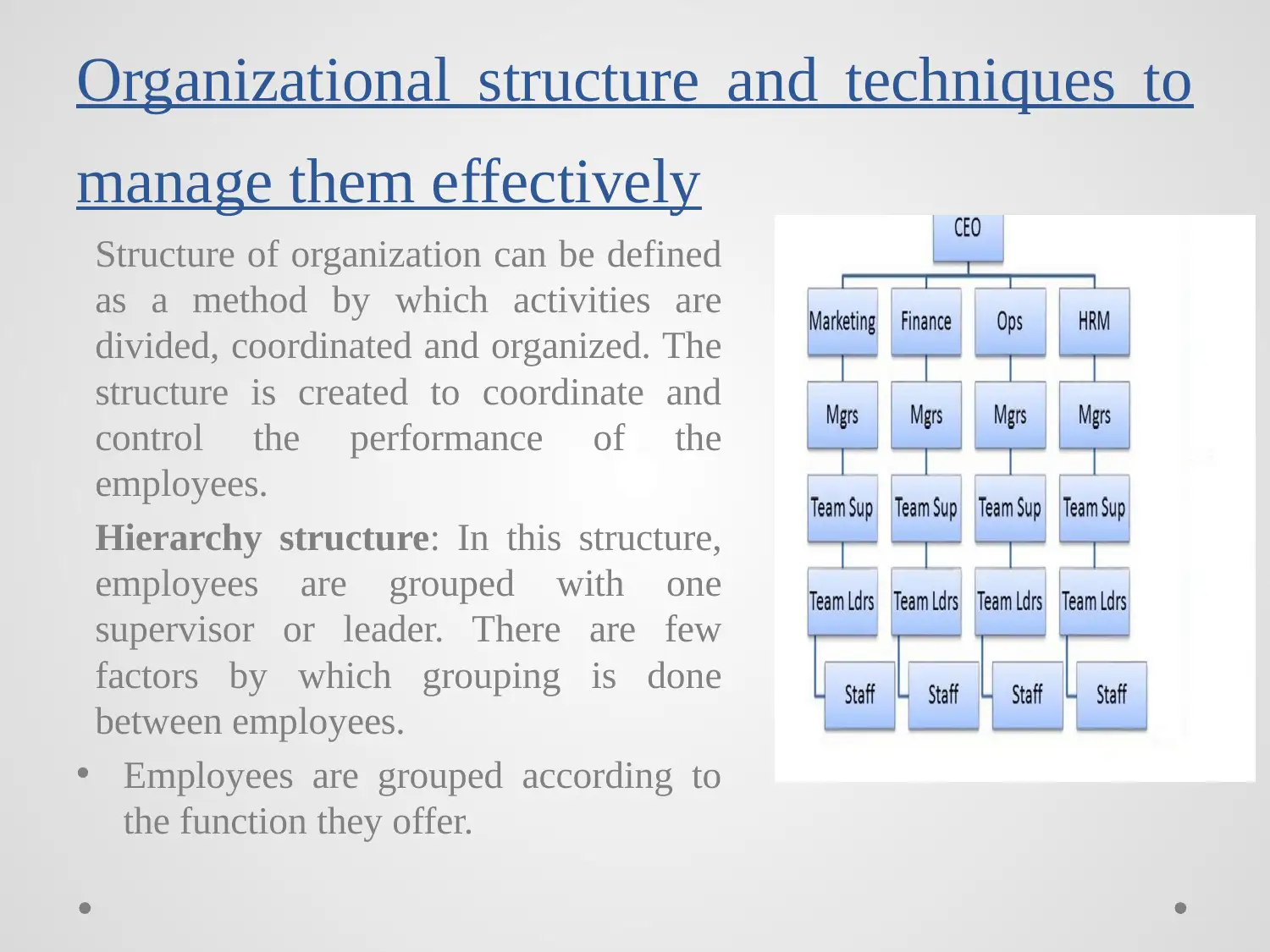
Organizational structure and techniques to
manage them effectively
Structure of organization can be defined
as a method by which activities are
divided, coordinated and organized. The
structure is created to coordinate and
control the performance of the
employees.
Hierarchy structure: In this structure,
employees are grouped with one
supervisor or leader. There are few
factors by which grouping is done
between employees.
• Employees are grouped according to
the function they offer.
manage them effectively
Structure of organization can be defined
as a method by which activities are
divided, coordinated and organized. The
structure is created to coordinate and
control the performance of the
employees.
Hierarchy structure: In this structure,
employees are grouped with one
supervisor or leader. There are few
factors by which grouping is done
between employees.
• Employees are grouped according to
the function they offer.
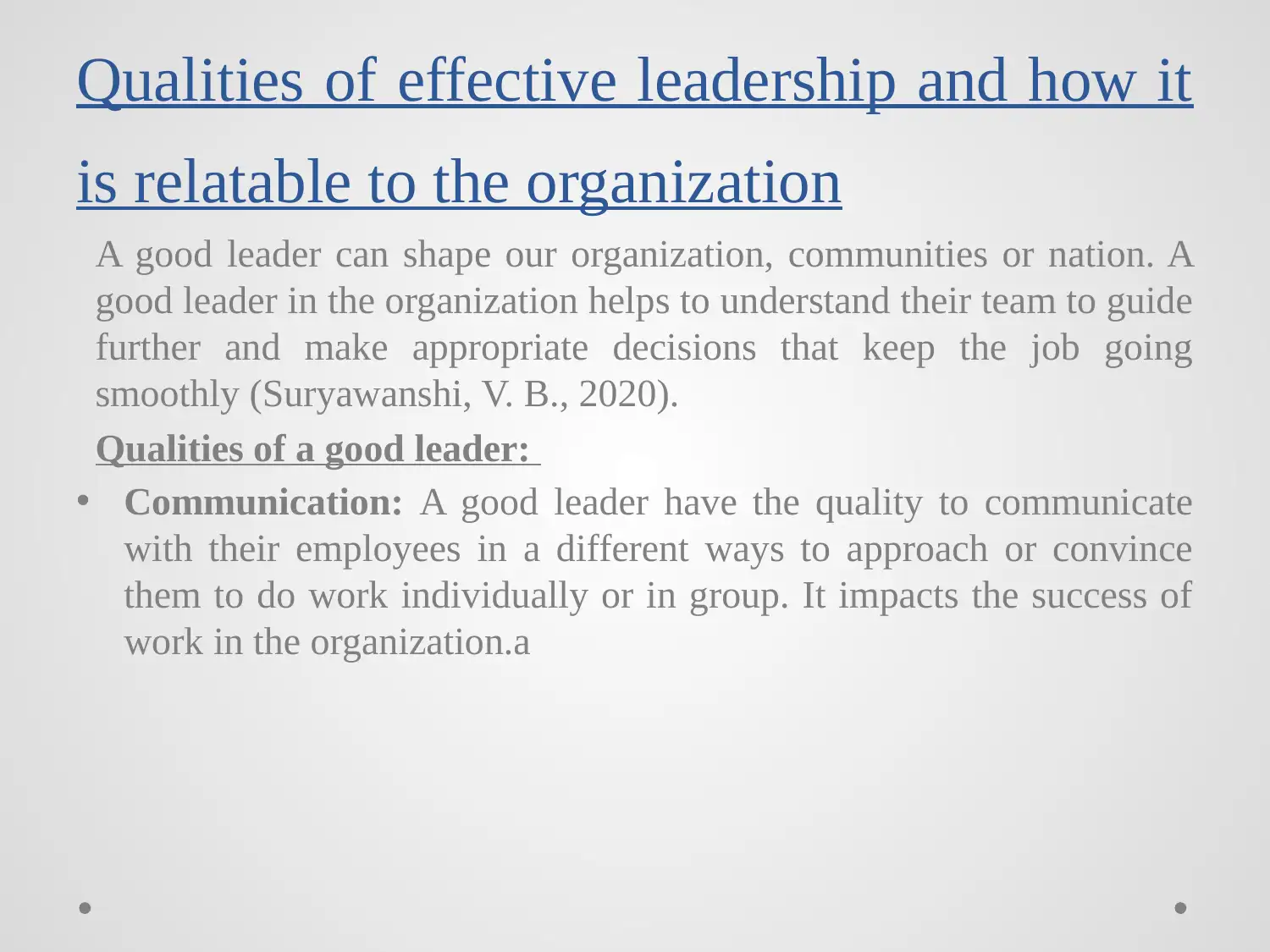
Qualities of effective leadership and how it
is relatable to the organization
A good leader can shape our organization, communities or nation. A
good leader in the organization helps to understand their team to guide
further and make appropriate decisions that keep the job going
smoothly (Suryawanshi, V. B., 2020).
Qualities of a good leader:
• Communication: A good leader have the quality to communicate
with their employees in a different ways to approach or convince
them to do work individually or in group. It impacts the success of
work in the organization.a
is relatable to the organization
A good leader can shape our organization, communities or nation. A
good leader in the organization helps to understand their team to guide
further and make appropriate decisions that keep the job going
smoothly (Suryawanshi, V. B., 2020).
Qualities of a good leader:
• Communication: A good leader have the quality to communicate
with their employees in a different ways to approach or convince
them to do work individually or in group. It impacts the success of
work in the organization.a
⊘ This is a preview!⊘
Do you want full access?
Subscribe today to unlock all pages.

Trusted by 1+ million students worldwide
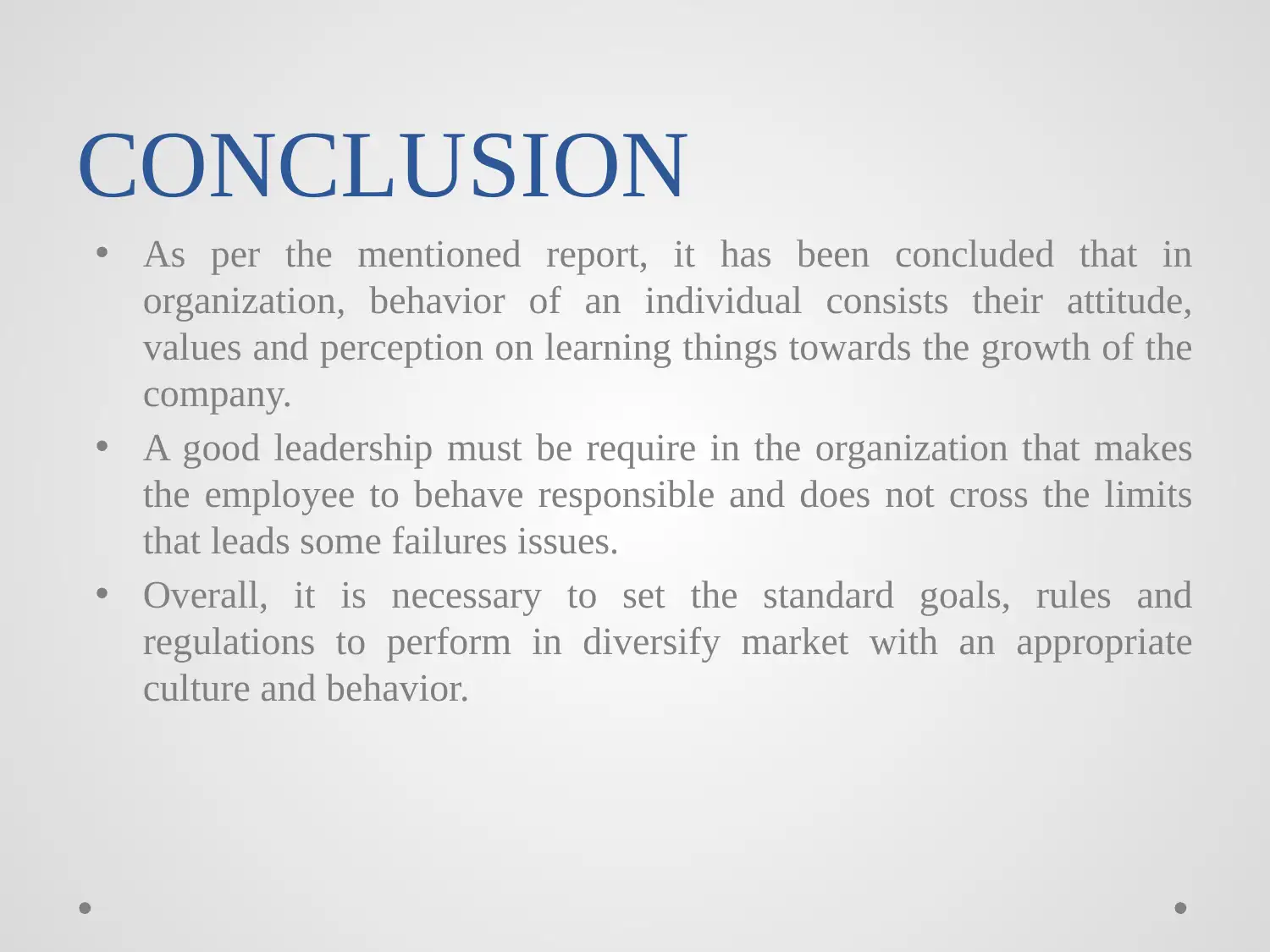
CONCLUSION
• As per the mentioned report, it has been concluded that in
organization, behavior of an individual consists their attitude,
values and perception on learning things towards the growth of the
company.
• A good leadership must be require in the organization that makes
the employee to behave responsible and does not cross the limits
that leads some failures issues.
• Overall, it is necessary to set the standard goals, rules and
regulations to perform in diversify market with an appropriate
culture and behavior.
• As per the mentioned report, it has been concluded that in
organization, behavior of an individual consists their attitude,
values and perception on learning things towards the growth of the
company.
• A good leadership must be require in the organization that makes
the employee to behave responsible and does not cross the limits
that leads some failures issues.
• Overall, it is necessary to set the standard goals, rules and
regulations to perform in diversify market with an appropriate
culture and behavior.
Paraphrase This Document
Need a fresh take? Get an instant paraphrase of this document with our AI Paraphraser
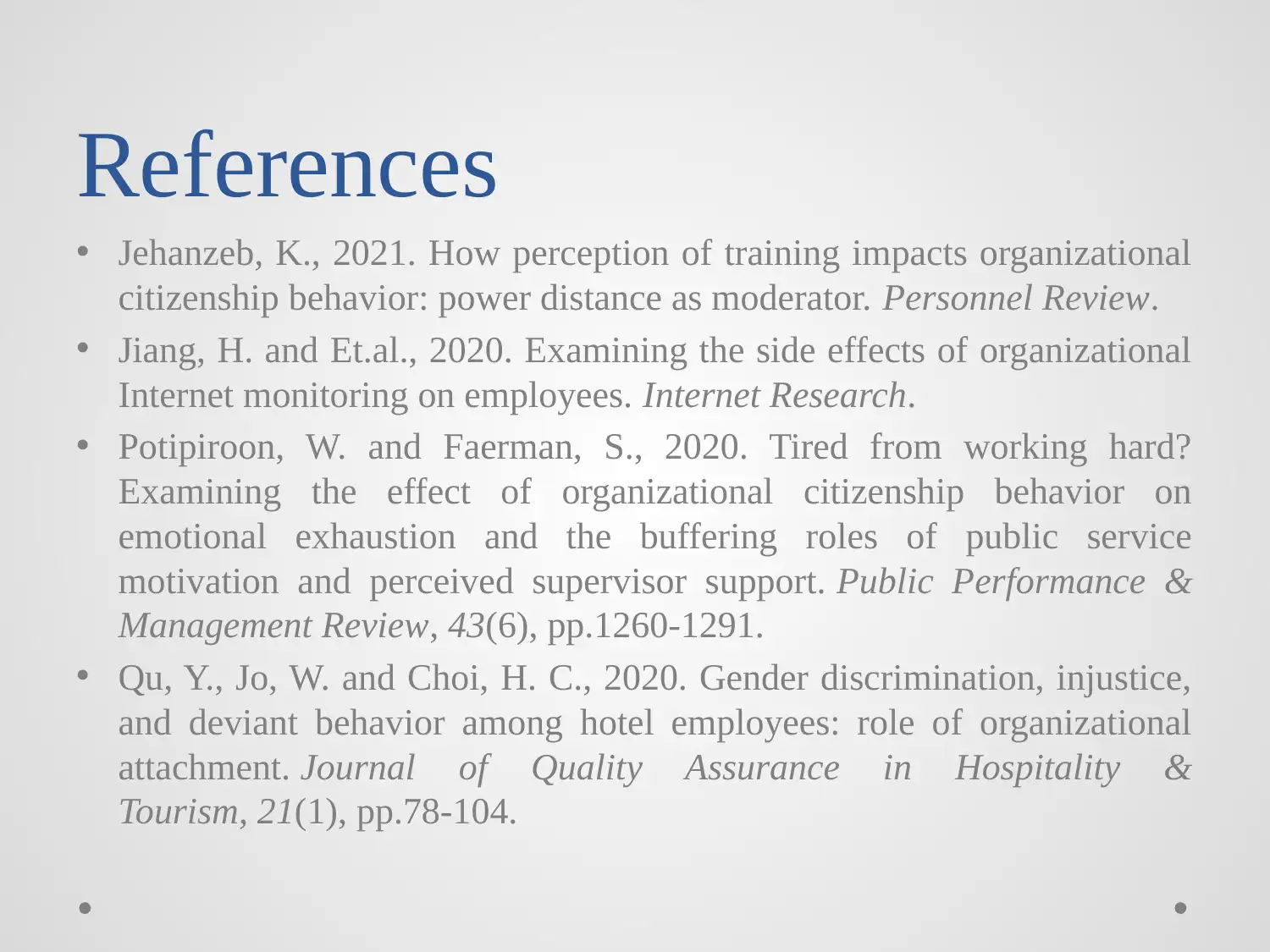
References
• Jehanzeb, K., 2021. How perception of training impacts organizational
citizenship behavior: power distance as moderator. Personnel Review.
• Jiang, H. and Et.al., 2020. Examining the side effects of organizational
Internet monitoring on employees. Internet Research.
• Potipiroon, W. and Faerman, S., 2020. Tired from working hard?
Examining the effect of organizational citizenship behavior on
emotional exhaustion and the buffering roles of public service
motivation and perceived supervisor support. Public Performance &
Management Review, 43(6), pp.1260-1291.
• Qu, Y., Jo, W. and Choi, H. C., 2020. Gender discrimination, injustice,
and deviant behavior among hotel employees: role of organizational
attachment. Journal of Quality Assurance in Hospitality &
Tourism, 21(1), pp.78-104.
• Jehanzeb, K., 2021. How perception of training impacts organizational
citizenship behavior: power distance as moderator. Personnel Review.
• Jiang, H. and Et.al., 2020. Examining the side effects of organizational
Internet monitoring on employees. Internet Research.
• Potipiroon, W. and Faerman, S., 2020. Tired from working hard?
Examining the effect of organizational citizenship behavior on
emotional exhaustion and the buffering roles of public service
motivation and perceived supervisor support. Public Performance &
Management Review, 43(6), pp.1260-1291.
• Qu, Y., Jo, W. and Choi, H. C., 2020. Gender discrimination, injustice,
and deviant behavior among hotel employees: role of organizational
attachment. Journal of Quality Assurance in Hospitality &
Tourism, 21(1), pp.78-104.
1 out of 11
Related Documents
Your All-in-One AI-Powered Toolkit for Academic Success.
+13062052269
info@desklib.com
Available 24*7 on WhatsApp / Email
![[object Object]](/_next/static/media/star-bottom.7253800d.svg)
Unlock your academic potential
Copyright © 2020–2025 A2Z Services. All Rights Reserved. Developed and managed by ZUCOL.





